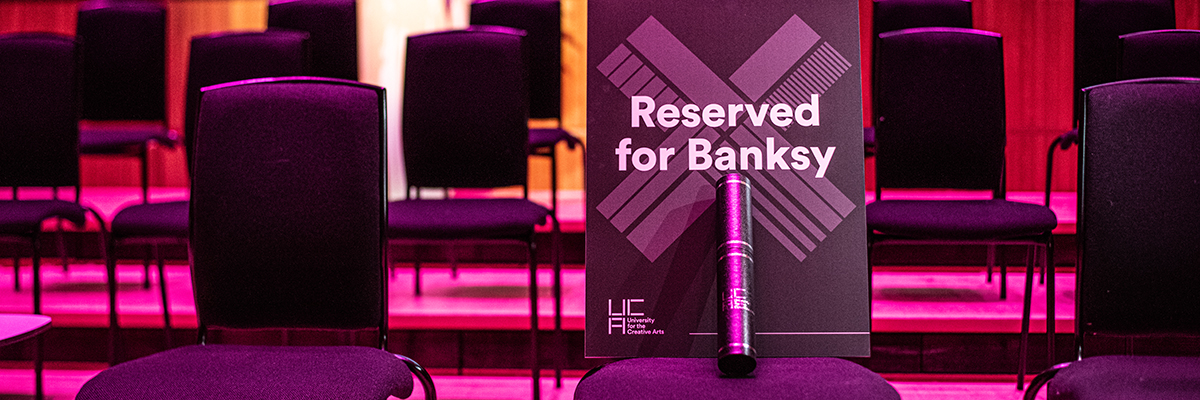Every summer we are regaled by the ceremony and spectacle of graduation season – with its robes, mortarboards, diplomas, and celebrity honorees. While a traditional graffiti or street artist may have opted for education by the school of the streets, countless halls of academia annually take creatives under their wing and tutelage to guide and prepare for a professional life in myriad careers in the arts.
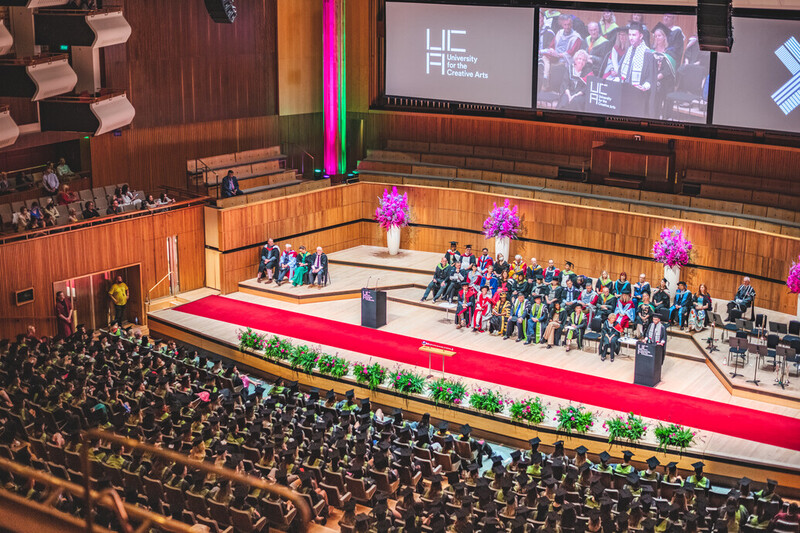
Studying everything from fashion to film to fine art, architecture, animation, and gaming design, the 7,000 students from 70 countries populate four campuses of The University for Creative Arts in southeast England. The disciplines may or may not intersect, but it’s fair to say that most of them have heard of that international mystery street artist/collective known singularly as Banksy. Who better to be made an honorary professor? So last month hundreds of graduating students of 2020, 2021, and 2022 enjoyed their moment in the Royal Festival Hall spotlight along with an empty chair and diploma meant for the most famous street artist in the world. By the end of the ceremony, the chair remained.
The diploma did not.
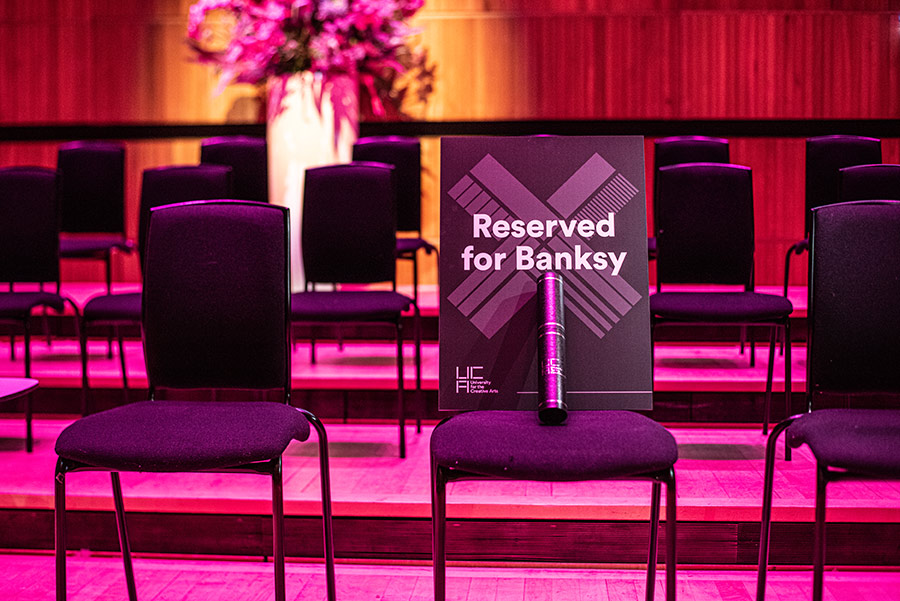
Brooklyn Street Art is honored today to have two people who attended that ceremony to share their experience with BSA readers: the artist, professor, art critic, contributing editor for Art in America, and author of Banksy: Completed (The MIT Press) Carol Diehl, and the Head of School Fine Art & Photography and the Assistant Vice-Chancellor at MCA, Terry Perk. Mr. Perk gave the invocatory speech for Banksy and sat next to the mystery artist’s chair onstage, while Ms. Diehl observed from her perch in the audience.
Both give us their view of the event and are interviewed here – an illuminating series of insights that broadens one’s appreciation for the contributions Banksy has made to global culture, geopolitics, the art world, and the street – from a scholarly perspective. Both Diehl and Perk have studied the artist’s work at great length, at one point traveling together to Bethlehem to investigate the artist’s Walled Off Hotel.
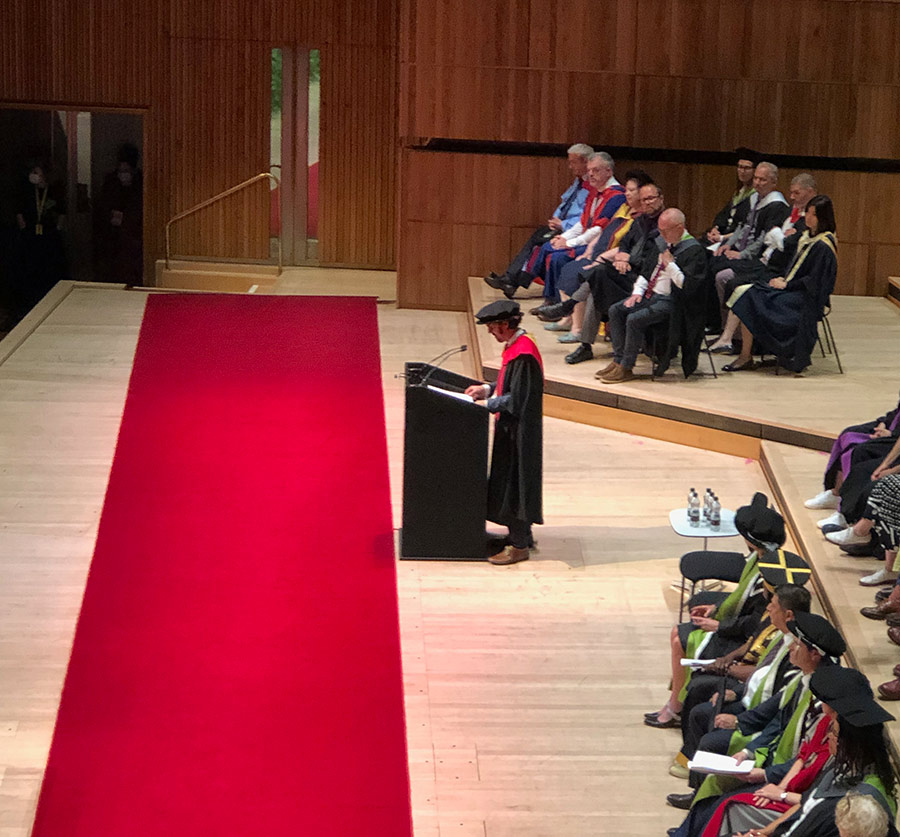
In his speech, which we publish in full at the end of the article, Perk asserts that “Perhaps more than any other contemporary artist, Banksy’s imagination resonates and appeals beyond the limited purview of the art world to the public at large. His use of humour, irony and recognisable symbolism have made his work poignant and universally accessible.”
In addition to the award of an Honorary Professorship that day, “what also made the news was a student who filched Banksy’s diploma from the empty chair,” Diehl tells us.
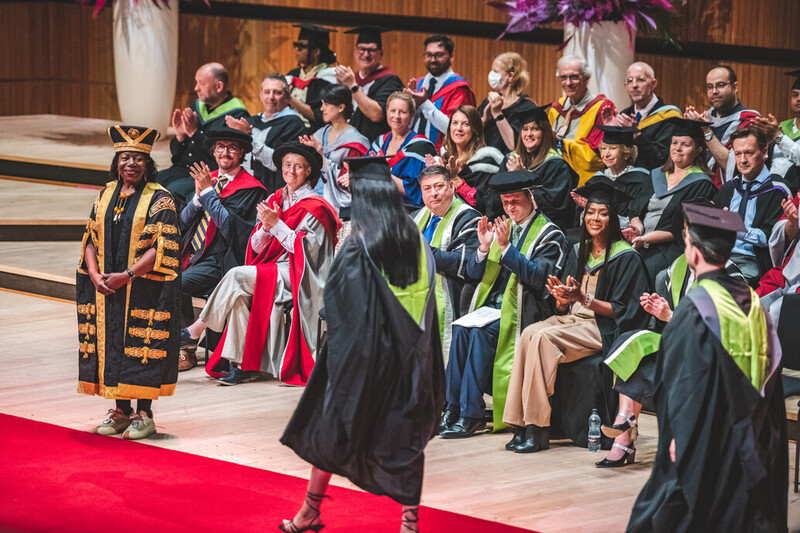
ArtDependence Magazine described the event this way: “Despite the student body being told that while walking across the stage you were just meant to nod once for the chairwoman and once more for your head of school, Ben Wray, a Film and Digital Art graduate, decided that after nodding to the chairwoman he would defy the university by leaving the stage with Banksy’s Professorship in hand. His stunt was met with cheers from the crowd and confusion from the staff who sat on stage.”
According to the writer, Mr. Wray commented “The University for the Creative Arts and I have had a bitter relationship over the past 3 years, this was my way of blowing one final kiss of poison before leaving forever.” In a subtle storyline twist worthy of the pithy Banksy, Wray continued, “That being said, I’m looking forward to start teaching there in September”.
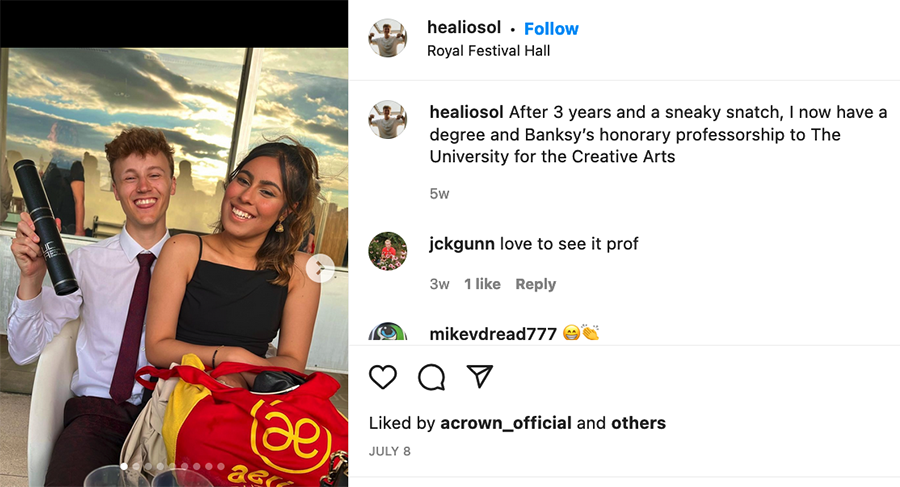
Banksy is said to have “liked” Ben’s Instagram post for a short time, then rescinded it. Perhaps you can ask Ben to show you his screenshots.
We asked Carol Diehl and Terry Perk to share their insights and observations regarding the honoring of the anonymous Banksy at The University for Creative Arts with a professorship.
Brooklyn Street Art: Since we don’t know who Banksy is, you have previously posited the view that the message is front and foremost. If this was considered a performance piece, what would you say the message is?
Carol Diehl: Yes, Banksy’s anonymity not only enables him to do his illegal work in secret and, instead of drifting off into the usual celebrity gossip (what was he wearing? nothing!), keeps the public focused on his message. Considering Banksy an ultimate provocateur, I regard all his work as conceptual/performance art, hence “completed” by the events it instigates, such as this one. Makhoul framed the artist as “an example that UCA students can look up to, who uses his talents to disrupt the status quo, while challenging us all to confront some of the key issues of our time: war and peace, inequality, and art’s role as a vehicle of social expression”.
Terry Perk: I think part of art’s unique value is that it avoids explicit messages. This, however, wasn’t an artwork, but a ceremony celebrating the hard-won achievements of a university’s students and staff. Although with Banksy’s absence in mind, it’s hard not to raise a smile at the ritual pomp and dress of the whole affair, dating back to 12th century guilds and the attire of medieval clergy, when the “star” of the show doesn’t even choose to be present. Maybe one of the messages is not to take ourselves too seriously – and perhaps anonymity is the ultimate expression of that.
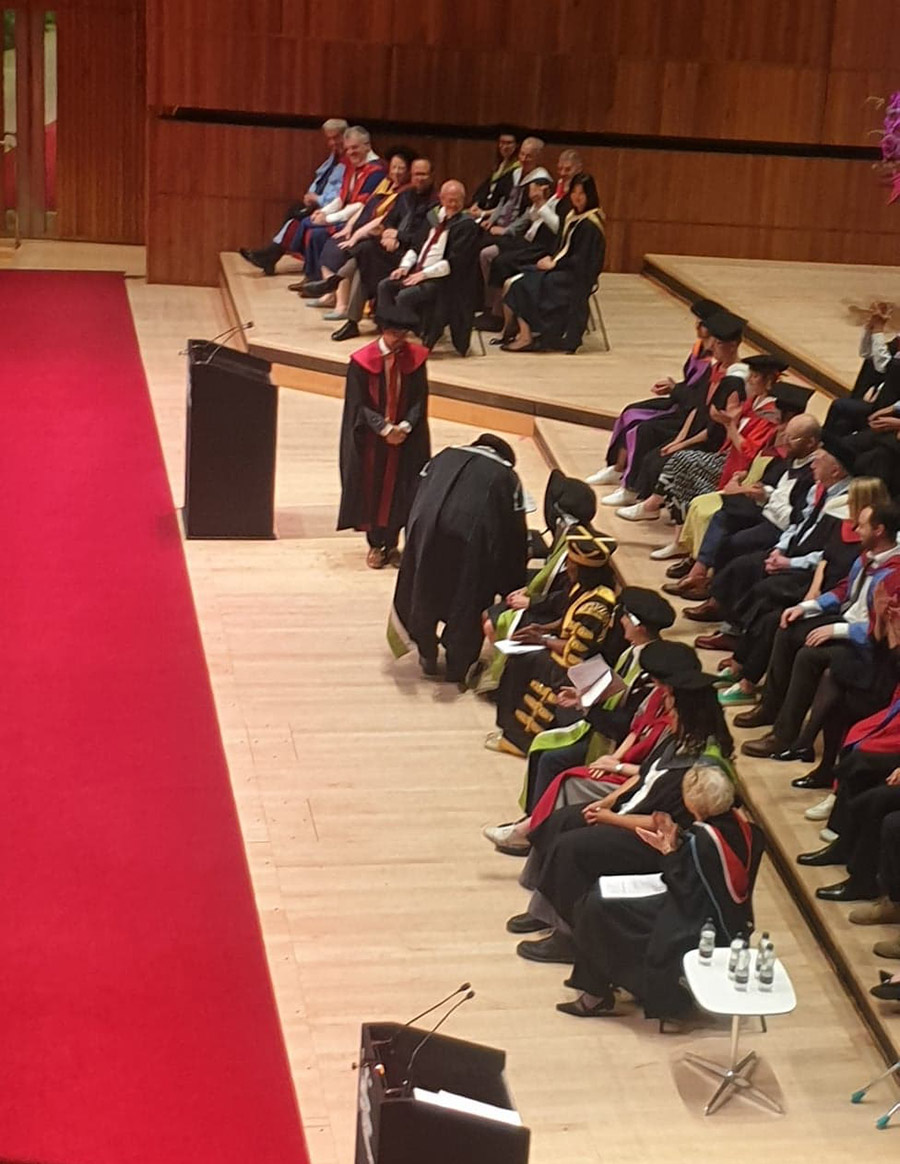
Brooklyn Street Art: In your evolution as a Banksy book author, you say that the New York art critic Jerry Saltz failed to properly appreciate the critique of the “Art World” that was before him when viewing a Banksy piece on a city street. Would you say that this performance, this event, is an unappreciated critique as well?
Carol Diehl: When Saltz scoffed at Banksy’s piece that included the phrase “You complete me,” he failed to consider that it could possibly be referring to him—an art critic who dismissed the piece as inconsequential without having gone to the accompanying “audio guide” and a voice that asked, “Are you looking for one of the great artworks of the 21st century? If so, you’re in the wrong place!” before devolving into artspeak gobbledegook. My point there being that the “Art World” takes itself so seriously that its spokespersons are eager to cast judgment without bothering to fully examine art that lacks its imprimatur—IOW, won’t apply their own criteria to anything that hasn’t already passed judgment.
Terry Perk: The fact that this kind of recognition of an artist who has had such an impact on the political and cultural imagination has had to come from outside the art world is in itself a critique of the art world.
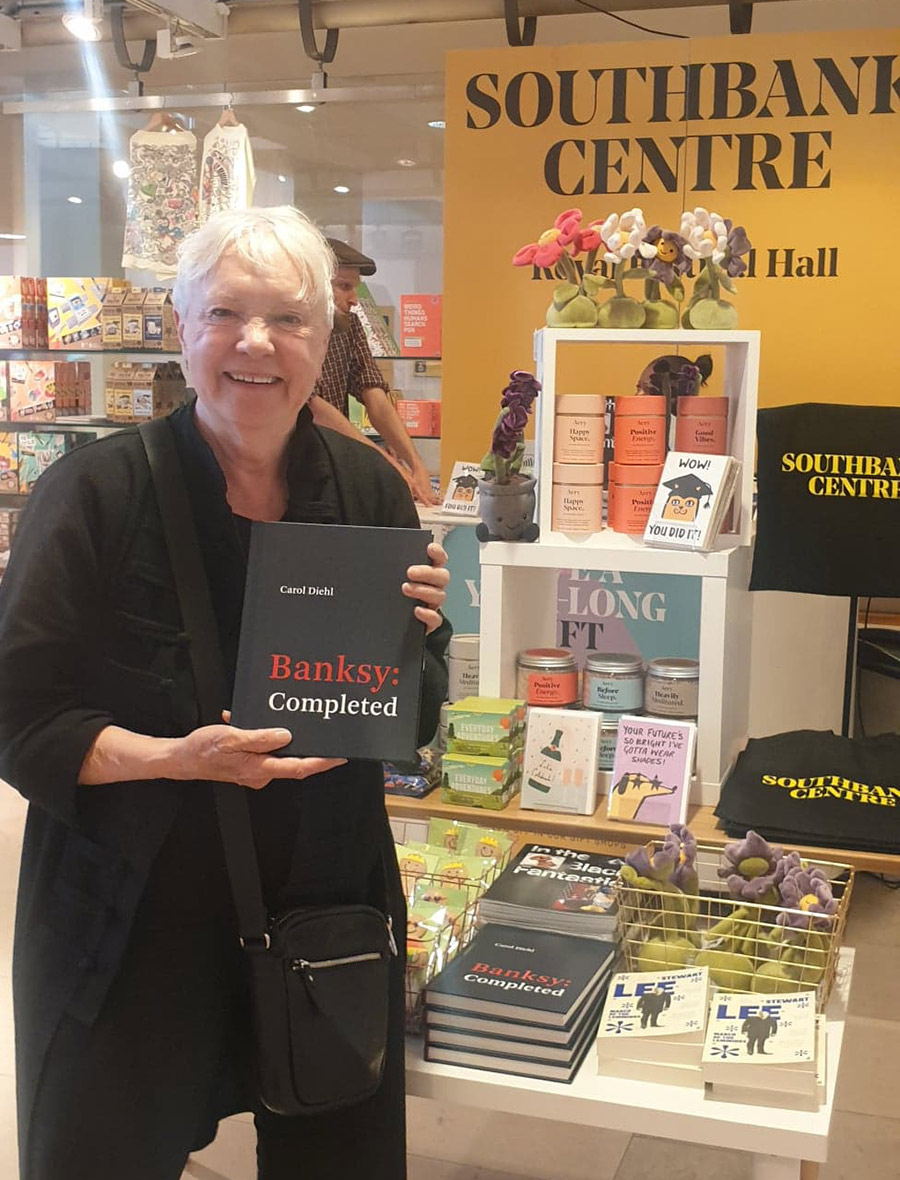
Brooklyn Street Art: Banksy’s work is honored at this event for addressing consequential matters: war, peace, and inequality. He hasn’t shied away from commentary on the Israelis and Palestinians, or the treatment of refugees. Is this award likely to impact the creative students and faculty of UCA?
Carol Diehl: Hopefully, of course, it will have an impact. But it’s important to point out that it would be very unlikely that a US university would go near such issues. And interesting to observe that while anything Banksy gets a lot of play in the US press, this event slid under the radar.
Terry Perk: Key to note from a university perspective is that we aren’t nationalistic in any sense. We are humanist. Our students are individuals, and our Vice Chancellor has spoken eloquently about how we wouldn’t seek to exclude an individual based on nationalistic politics, or the political decisions of their government. Imagine if international universities didn’t open their doors to American citizens, just because they disagreed with a particular aspect of the US governments foreign policy. Equating all individual citizens with the decisions of their governments is nationalistic mis-thinking.
Brooklyn Street Art: Has Banksy’s Pest Control organization authenticated that it was actually Banksy who did not attend the ceremony?
Carol Diehl: Well, as Terry Perk’s tribute pointed out, rather than try to pin down Banksy, we can use the ceremony to ask “What does it mean to be Banksy?” “Am I Banksy? What do I stand for?” And most importantly: “What do we stand for together? – knowing that the one thing we have in common is our difference.”
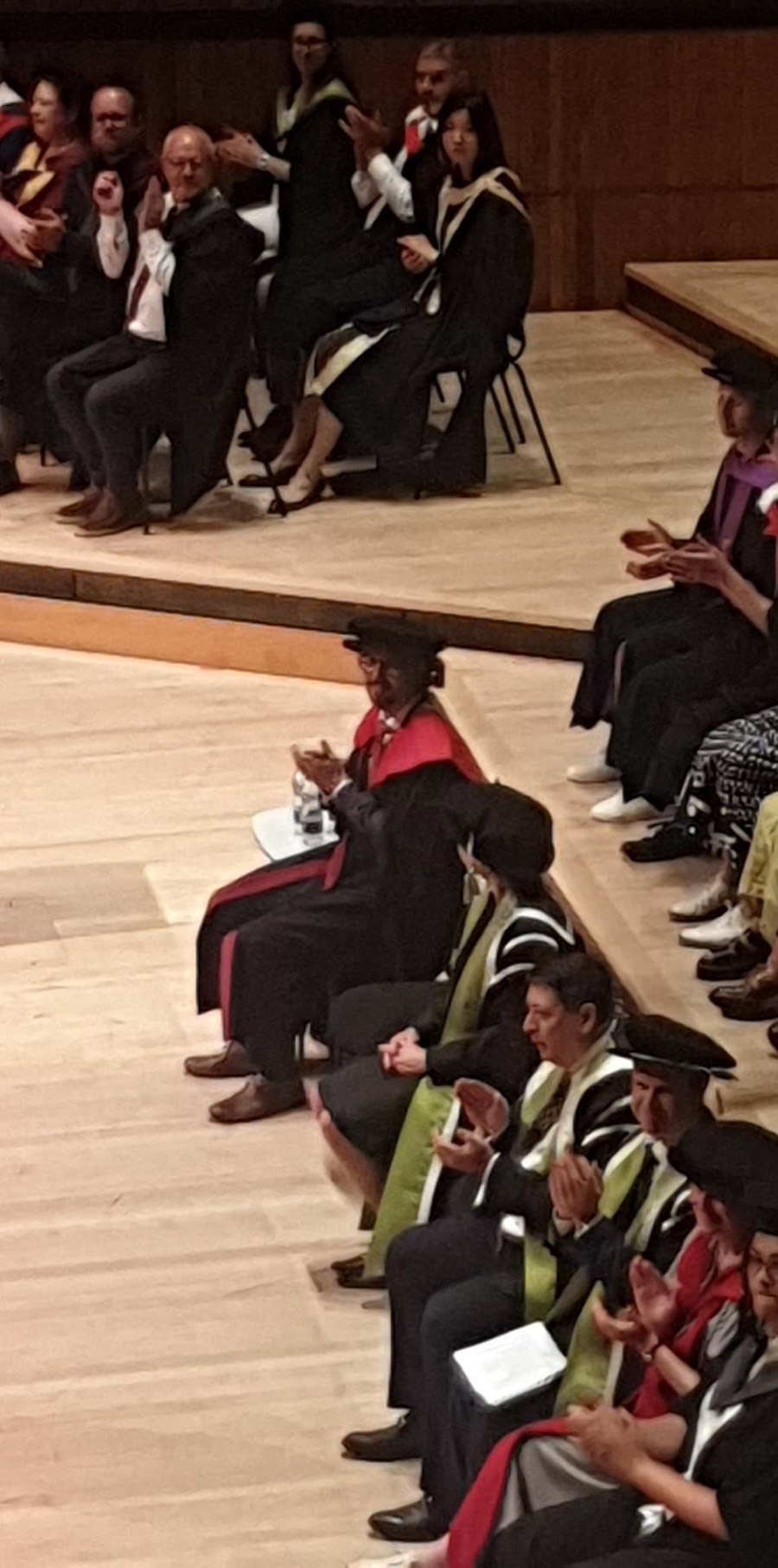
Brooklyn Street Art: The graduate who stole the professorship diploma at his own graduation posted the stunt on his Instagram account and Banksy briefly “liked” it before deleting his reaction. What was your first impression of this maneuver while you were witnessing it in real-time?
Terry Perk: I was seated next to the empty chair with the scroll on it, and was caught by surprise. As the student moved across the stage they quite quickly changed direction towards the chair – my instinct was to reach out and grab the scroll at the same time, but they were too quick. As they walked away I couldn’t help but smile and applaud. I’m not surprised Banksy ‘liked’ what was a rather audacious and rebellious act – blurring the boundaries of ownership, property and theft is one of the persistent themes and institutional critiques in Banksy’s work. Equally, I wouldn’t be surprised to see the scroll on eBay sometime soon 
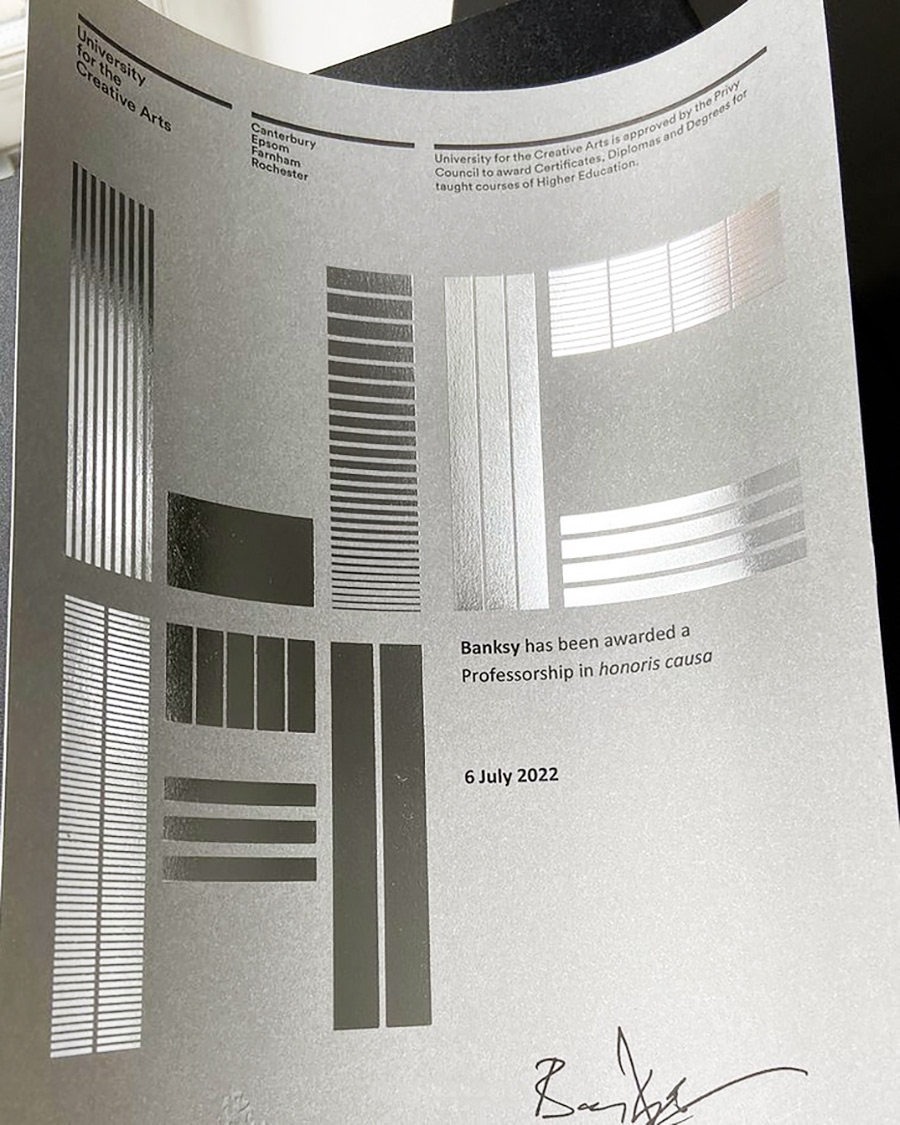
Terry Perk’s speech moving to confer the award of Honorary Professorship upon Banksy:
Vice Chancellor, Governors of the University, Worshipful Mayor, Guests and Graduates: In 2018 I visited Palestine for the first time, accompanying a friend, Carol Diehl, who was researching a book she was writing on Banksy. We’d journeyed to stay at Banksy’s latest artwork, The Walled Off Hotel (spelt ‘walled’ W-A-L-L-E-D), a mock British colonial hotel built within 10 feet of the barrier wall between Israel and the Palestinian West Bank. Adorned with his works and now entirely owned and run by Palestinians, Banksy created the hotel in 2017 to bring attention to the conditions in the area and provide a financial boost to a city whose economy was significantly diminished after the wall was built.
Operating anonymously, as an artist, humanitarian and political activist, Banksy’s work has always been culturally and politically responsive to the places he’s worked in. Whether for his one-month take-over of the streets of New York, in which he created a new artwork in the city every day, a 20-metre high Brexit-inspired mural of a blue collar worker chiselling off a star on the EU flag in Dover, or inviting 58 other artists to create Dismaland – a dystopian theme park in the seaside town of Weston-super-Mare – his work has continually posed questions about the relationship between people, places and power, revealing society’s hypocrisies, and challenging us to reconsider art’s value and purpose. Perhaps more than any other contemporary artist, Banksy’s imagination resonates and appeals beyond the limited purview of the art world to the public at large. His use of humour, irony and recognisable symbolism have made his work poignant and universally accessible.
Banksy’s efforts have supported a range of humanitarian projects, most recently his funding of a refugee rescue boat in the Mediterranean, the Louise Michel (named after the French feminist anarchist). As with The Walled Off Hotel and Dismaland, the appeal of his worksattracts large audiences, generating economic value for the host communities. A street artist in the broadest sense, Banksy’s work rallies against the forces of gentrification and representations of state and multi-national power. He writes:“The people who truly deface our neighbourhoods are the companies that scrawl giant slogans across buildings and buses trying to make us feel inadequate unless we buy their stuff.”
Adding,“… the war on graffiti is less about aesthetics than control – after all, when graffiti is painted over, it’s usually done badly, and with a colour that doesn’t even match the wall.” This focus on our everyday engagement with our world, particularly the ubiquitous ways in which we are surreptitiously managed by advertising, packaging and signage, are at the heart of Banksy’s work. A trickster in the most earnest sense, his humorous projects shine alight on the disenfranchised and the disempowered.
Public art in its truest form, Banksy’s work often features images of nature and children, juxtaposing these symbols of innocence with those of war, commercialism, and authority, reframing the social, political and economic constructs that impact our lives: a rioter throwing a bouquet of flowers, a child patting down a soldier as part of a ‘stop and search’, a dove of peace wearing an armoured vest.Working illegally, Banksy’s anonymity removes any sense of personality or celebrity from our experience of his art, allowing for more attention on the works themselves and the questions they pose. He writes: “I don’t know why people are so keen to put the details of their private life in public; they forget that invisibility is a superpower”
Like the famous scene from Stanley Kubrik’s 1960 film Spartacus, in which all the slaves declare “I’m Spartacus,” the question to ask ourselves isn’t “Who is Banksy?” But “What does it mean to be Banksy?” — “Am I Banksy? What do I stand for?” And most importantly: “What do we stand for together?”– knowing that the one thing we have in common is our differences. With this challenge before us, and in recognition of his humanitarian work and unique contribution to the arts, the University for the Creative Arts takes great pride in bestowing this honour in absentia. I therefore formally ask our Vice Chancellor and President to confer the award of Honorary Professorship upon Banksy.
Terry Perk, Assistant Vice Chancellor, University for the Creative Arts
Carol Diehl is author of Banksy: Completed published in October 2021 by The MIT Press and Penguin Random House. Click HERE to learn more.
 BROOKLYN STREET ART LOVES YOU MORE EVERY DAY
BROOKLYN STREET ART LOVES YOU MORE EVERY DAY